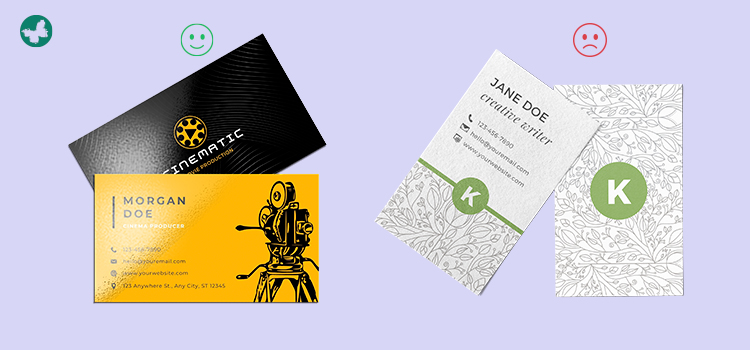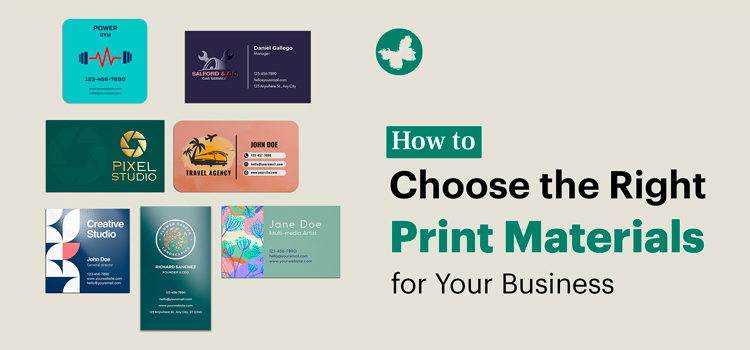Implementing a successful marketing campaign requires designing and printing various marketing tools. When it comes to printing, it can be challenging to choose from a wide variety of paper options. Since this decision significantly affects your marketing results, you must consider all the aspects of paper size, weight, type, and finishes. The next step is to match the proper material with the appropriate product to achieve the ideal results.
This article will explain everything you should know about choosing the right print materials for business. Butterfly GP has a long experience in printing products for a wide range of businesses. So, we know that it is not easy to find the right option in an ocean of different choices. You can use our experience and keep reading to find out which materials to use for which printing marketing products.
Read more: 6 Print Products to Help Small Businesses Stand Out from the Competitors.
Contents
Why Choosing the Right Print Materials Matters

The quality of the final printed product is generally impacted by the selection of print materials. This may include paper type and size, which affect everything from durability to clarity and colour vibrancy. Text and image appearance are directly influenced by the weight, texture, and finish of the paper. A positive brand image can be reinforced and customer satisfaction increased with high-quality printed materials.
Superior materials help create a more polished and expert look that leaves a greater impression on the audience. Clear, sharp, and easy-to-read text and images are guaranteed when the proper paper and ink are used. For the best printed products, follow these instructions:
Paper Type
The visual appeal, longevity, and general efficacy of print marketing products are all greatly impacted by the type of paper used. Each type of paper has unique characteristics and texture, which affect how text and images are viewed. Selecting the appropriate paper can improve the brand’s reputation, give it a high-end feel, and guarantee that the message is best understood. The table below compares different types of papers, their characteristics, and their common usage for printed materials. This short but detailed guide can help you find out the different applications of various paper types:
Paper Type Comparison
| Paper Type | Characteristics | Common Uses |
| Bond Paper | Durable, smooth, and relatively inexpensive. Suitable for everyday printing. | Letterheads, stationery, invoices, reports, flyers. |
| Offset Paper | Uncoated, absorbent, with good readability. | Books, newspapers, brochures, and manuals. |
| Coated Paper | improves the colour vibrancy and sharpness of images. Less absorbent than uncoated papers. | Magazines, brochures, postcards, catalogues, posters, and high-quality flyers. |
| Cardstock | Thicker and more rigid. Provides a sturdy feel. | Business cards, postcards, invitations, greeting cards, and presentation folders. |
| Text Paper | High-quality, often with a textured or patterned surface. They come in different colours and weights. | Invitations, brochures, menus, marketing materials, and art prints. |
| Newsprint | Inexpensive, lightweight, and uncoated paper made primarily from wood pulp. Has a greyish tone and low durability. | Newspapers. |
| Recycled Paper | Offers an environmentally friendly option. Available in various types, weights, and finishes. | Daily printings and high-quality marketing products. |
| Photo Paper | Specifically designed for printing photographs. Often coated with a glossy, semi-gloss, or matte finish. | Photographs, art prints. |
| Transparency Paper | Clear or frosted sheets, designed for overhead projectors or creating overlays. | Presentations, technical drawings. |
| Synthetic Paper | Made from plastic polymers, making it water-resistant, tear-resistant, and durable with various finishes. | Outdoor signage, waterproof labels, menus, maps, and durable documents. |
Paper’s Weight
The quality, durability, and general feel of print marketing materials are all greatly impacted by paper weight. You’d better use heavier-weight papers to produce a more substantial and opaque final product. But lighter paper is more affordable and better suited for short-term or disposable materials, such as handouts for events.
Paper’s Weight Comparison
| Paper Weight (gsm – International) | Characteristics | Common Uses |
| ~75 gsm bond | Lightweight, standard copy paper. | Daily printings, drafts, and internal documents. |
| ~90 gsm bond | Slightly heavier and more substantial. | Reports, proposals, presentations. |
| ~105 gsm bond | Heavier still, more premium feel. | High-quality letterhead and stationery. |
| ~90-120 gsm text | With a smoother or textured finish. | Brochures, flyers, newsletters. |
| ~120-150 gsm text | Thicker and more substantial text paper. Feels more luxurious. | Premium brochures, marketing materials, and posters. |
| ~176 gsm cover | Lightweight cardstock. | Booklet covers, postcards, invitations. |
| ~216 gsm cover | Medium-weight cardstock with good rigidity. | Business cards, presentation folders, and heavier postcards. |
| ~270 gsm cover | Heavy cardstock, very sturdy. | Premium business cards, invitations, and tags. |
| ~310 gsm cardstock | Thick and durable. | Business cards, thicker postcards. |
| ~350 gsm cardstock | More rigid and even thicker cardstock. Offers a very high-end feel. | High-end business cards, sturdy invitations. |
Paper Size
Paper size has a big influence on print marketing products because it affects the overall customer experience, cost, message clarity, and visual appeal. The tactile feel of your printed materials can also be improved by using the appropriate paper size. This will strengthen your message and make an ideal impression.
Paper Size Comparison
| Paper Size (North America) |
Dimensions (inches) | Common Uses |
| Letter | 8.5 x 11 | Standard for business and academic documents, letters, and reports. |
| Legal | 8.5 x 14 | Better for legal documents and spreadsheets with more columns. |
| Tabloid (Ledger) | 11 x 17 | Larger documents, spreadsheets, posters, and layouts. |
| Executive | 7.25 x 10.5 | Smaller, more formal-looking size for stationery and reports. |
| A3 | 11.7 x 16.5 | Used for architectural drawings, large diagrams, and posters. |
| A4 | 8.3 x 11.7 | Common for documents, reports, and general printing. |
| A5 | 5.8 x 8.3 | Used for notebooks, booklets, and promotional flyers. |
| A6 | 4.1 x 5.8 | Postcards, small flyers, and invitations. |
| Business Card | 3.5 x 2 | Standard size for business cards. Variations exist. |
| Postcard | Various | Common sizes include 4 x 6, 5 x 7, and 6 x 9 inches. |
Paper Finish
Your printed marketing materials’ readability, visual impact, and overall brand image are all significantly impacted by the paper finish you choose. For example, glossy finishes highlight vivid images and produce a polished, high-impact impression. On the other hand, matte finishes are best for text-heavy materials, offering a more professional appearance.
Paper Finish Comparison
| Paper Finish | Characteristics | Common Uses |
| Gloss | Smooth and glossy. Improves image detail and colour vibrancy. It can be vulnerable to fingerprints. | Magazines, brochures, photographs, postcards. |
| Matte | Non-reflective surface with superior readability and a chic appearance. Colours seem softer and less vivid. | Books, reports, stationery, brochures, and direct mail. |
| Satin/Silk | Semi-gloss finish with a silky, soft texture. Provides good colour reproduction. | Magazines, brochures, invitations, and art prints. |
| Uncoated | It feels natural and tactile, and it’s great for writing on. Colours seem more muted. | Stationery, envelopes, books, and newspapers. |
| Textured | The surface has a distinct pattern or texture. Adds visual and tactile appeal. | Invitations, stationery, business cards. |
| Varnish (Spot/Overall) | Adds contrast to improve visual appeal while offering protection. | Book covers and brochures. Good for highlighting specific parts. |
| Laminate (Gloss/Matte) | The surface is covered with a thin layer of plastic that provides exceptional tear, water, and durability resistance. Matte laminate provides a non-reflective finish, while gloss laminate adds shine. | Book covers, menus, business cards, and outdoor signage. |
| Soft-Touch | A matte finish that feels soft and smooth to the touch. Makes a lasting, high-quality impression. | High-end business cards, brochures, and packaging. |
Read more: Types of Print Finishes: What You Need to Know
Matching Print Materials with Print Products
The intended use and desired result determine the best fit between the print material and product type. Choose your print material carefully for the best marketing result. Don’t forget to use thicker paper (like cover stock) for products like business cards, postcards, and brochures for a more upscale appearance and durability.
Smaller paper sizes, such as A6 or postcards, are more portable and suitable for targeted advertising or messaging. However, for detailed information or eye-catching designs, larger sizes, such as A4 or posters, are better. For flyers and posters, lightweight paper works well for cost-effectiveness and wider distribution.
Common Mistakes Businesses Make When Choosing Print Materials
Many business owners do not have enough knowledge about the type or size of paper they need for different types of marketing products. Keep the following tips in mind, and try to avoid such mistakes for better results:
- Mistake: Not considering the paper stock or finish.
Tip: Select the appropriate paper for the project, make sure the files are prepared correctly, and check the print quality before the last run. - Mistake: Inadequate file preparation.
Tip: Make sure your file is in CMYK colour mode, contains high-resolution images (300 DPI or higher), and is in the proper format (PDF, EPS, or TIFF). - Mistake: Pay no attention to the print proofing step.
Tip: Print proofing for wholesale printing is a vital factor. Before completing your print run, make sure you carefully examine any digital or physical proofs, paying particular attention to important details.
Conclusion
Since the texture and resolution of the printing products completely depend on the paper type and finishes, never ignore choosing the right print material. This necessary step has a direct impact on your print quality and overall marketing plan. This article is a detailed guide on how you choose the right print materials for your business. You can also use the professional experience of a reliable print partner, like ButterflyGP, to assist you in finding the best print materials. Good luck!
